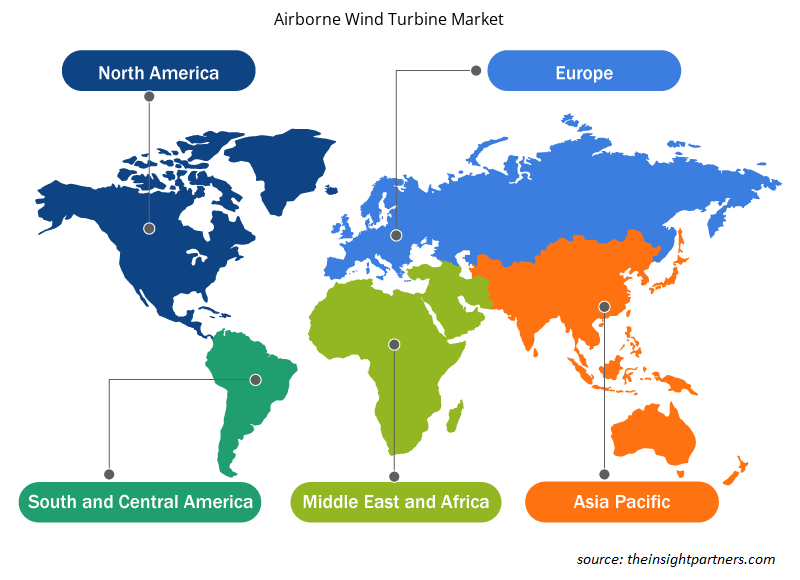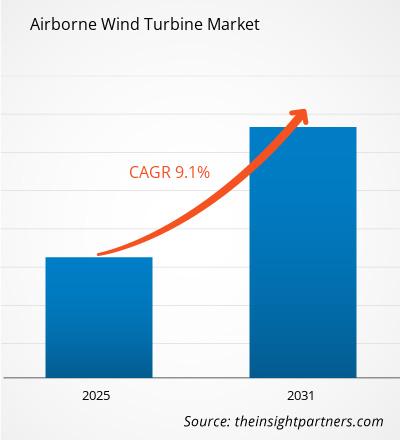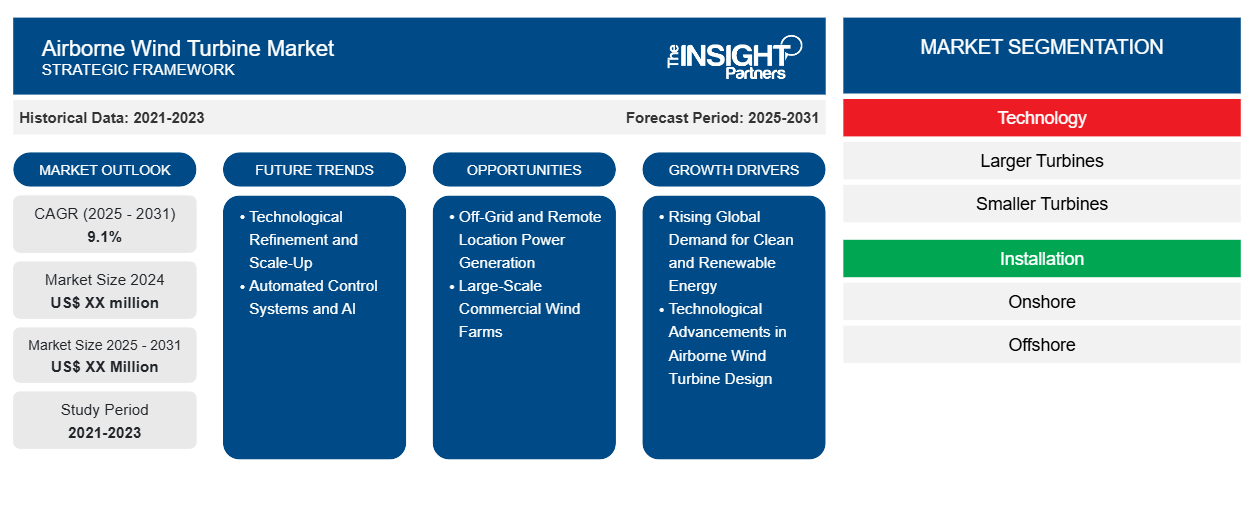预计 2023 年至 2031 年期间机载风力涡轮机市场复合年增长率为 9.1%,市场规模将从 2023 年的 XX 百万美元扩大到 2031 年的 XX 百万美元。
报告按技术(大型涡轮机(3MV 以上)、小型涡轮机(3MV 以下))和安装(陆上、海上)进行细分。全球分析进一步细分为区域和主要国家。报告以美元为单位提供上述分析和细分的价值。
报告目的
Insight Partners 发布的《空中风力涡轮机市场》报告旨在描述当前形势和未来增长、主要驱动因素、挑战和机遇。这将为各种业务利益相关者提供见解,例如:
- 技术提供商/制造商:了解不断变化的市场动态并了解潜在的增长机会,从而能够做出明智的战略决策。
- 投资者:对市场增长率、市场财务预测以及整个价值链中存在的机会进行全面的趋势分析。
- 监管机构:监管市场政策和警察活动,旨在最大限度地减少滥用行为,维护投资者的信任和信心,维护市场的完整性和稳定性。
机载风力涡轮机市场细分
技术
- 大型涡轮机
- 小型涡轮机
安装
- 陆上
- 海上
定制此报告以满足您的需求
您可以免费定制任何报告,包括本报告的部分内容、国家级分析、Excel 数据包,以及为初创企业和大学提供优惠和折扣
- 获取此报告的关键市场趋势。这个免费样品将包括数据分析,从市场趋势到估计和预测。
空中风力涡轮机市场的增长动力
- 全球对清洁和可再生能源的需求不断增长:随着世界越来越多地转向可再生能源以应对气候变化,空中风力涡轮机提供了一种产生清洁电力的全新创新方式。政府、公用事业和私人投资者正在寻找可扩展且具有成本效益的解决方案,以满足不断增长的能源需求,同时减少碳排放。全球对可持续发展和向低碳能源转型的推动是空中风力涡轮机系统开发和商业应用的主要驱动力。
- 机载风力涡轮机设计的技术进步:轻质材料、空气动力学、系留系统和自动控制系统的技术进步显著提高了机载风力涡轮机的性能和可靠性。动态系统的创新使涡轮机能够自主飞行和控制方向,从而使机载风力涡轮机变得更加高效,能够适应不断变化的风况。随着技术的不断发展,生产成本预计将下降,从而使机载风力涡轮机在可再生能源市场上更具竞争力。
空中风力涡轮机市场未来趋势
- 技术改进和规模扩大:随着空中风力涡轮机越来越接近商业可行性,该行业将看到技术规模扩大的重大推动力。在未来十年,公司可能会专注于改进设计,以提高空中系统的能源效率、稳定性和可靠性。更大、更强大的涡轮机以及更耐用的系留系统将变得更加普遍。市场还将看到控制算法和自动飞行系统的创新,这将有助于提高空中风力涡轮机的效率并适应不同的风况。
- 自动控制系统和人工智能:空中风力涡轮机将越来越多地利用人工智能 (AI) 和机器学习算法来实时优化其性能。自动化系统将能够根据实时风况调整涡轮机的飞行路径、高度和方向,从而提高能量捕获率并减少磨损。人工智能还可以协助进行预测性维护,提供有关涡轮机健康状况的实时数据并帮助操作员更有效地安排维护。
空中风力涡轮机市场机遇
- 离网和偏远地区发电:空中风力涡轮机最有吸引力的机会之一是离网和偏远地区,传统风力发电场可能无法在这些地区使用。空中系统便于携带,需要的塔架和地基等基础设施较少,可以部署在难以到达的地区或小规模作业中,例如岛屿、偏远社区、军事基地或受灾地区。这些应用可以提供分散、清洁且经济高效的发电。
- 大型商业风力发电场:空中风力涡轮机在大型风力发电场中也发挥着重要作用,特别是在陆基涡轮机效率低下或不切实际的地区。由于空中风力涡轮机可以在更高的高度运行,并且不需要大型物理基础设施,因此它们可以部署在城市地区、茂密的森林或农业用地中,而这些地方可能不适合传统的风力发电场。空中风力涡轮机可以补充传统的风力发电,为土地使用和能源生产提供灵活性。
空中风力涡轮机市场区域洞察
Insight Partners 的分析师已详细解释了预测期内影响机载风力涡轮机市场的区域趋势和因素。本节还讨论了北美、欧洲、亚太地区、中东和非洲以及南美和中美洲的机载风力涡轮机市场细分和地理位置。

- 获取机载风力涡轮机市场的区域特定数据
机载风力涡轮机市场报告范围
| 报告属性 | 细节 |
|---|---|
| 2023 年的市场规模 | XX 百万美元 |
| 2031 年市场规模 | XX 百万美元 |
| 全球复合年增长率(2023 - 2031) | 9.1% |
| 史料 | 2021-2022 |
| 预测期 | 2024-2031 |
| 涵盖的领域 | 按技术分类
|
| 覆盖地区和国家 | 北美
|
| 市场领导者和主要公司简介 |
|
空中风力涡轮机市场参与者密度:了解其对业务动态的影响
机载风力涡轮机市场正在快速增长,这得益于终端用户需求的不断增长,这些需求源于消费者偏好的不断变化、技术进步以及对产品优势的认识不断提高等因素。随着需求的增加,企业正在扩大其产品范围,进行创新以满足消费者的需求,并利用新兴趋势,从而进一步推动市场增长。
市场参与者密度是指在特定市场或行业内运营的企业或公司的分布情况。它表明在给定市场空间中,相对于其规模或总市场价值,有多少竞争对手(市场参与者)存在。
在机载风力涡轮机市场运营的主要公司有:
- 安迅纳公司
- 德温德公司
- 远景集团
- 通用电气公司
- 风筝磨坊
免责声明:上面列出的公司没有按照任何特定顺序排列。

- 了解机载风力涡轮机市场主要参与者概况
主要卖点
- 全面覆盖:报告全面涵盖了机载风力涡轮机市场的产品、服务、类型和最终用户的分析,提供了整体概况。
- 专家分析:报告基于对行业专家和分析师的深入了解而编写。
- 最新信息:该报告涵盖了最新信息和数据趋势,确保了其与业务的相关性。
- 定制选项:此报告可以定制以满足特定客户要求并恰当地适应业务策略。
因此,机载风力涡轮机市场研究报告有助于引领解读和了解行业情景和增长前景。尽管可能存在一些合理的担忧,但本报告的总体优势往往大于劣势。
- 历史分析(2 年)、基准年、预测(7 年)及复合年增长率
- PEST和SWOT分析
- 市场规模、价值/数量 - 全球、区域、国家
- 行业和竞争格局
- Excel 数据集
近期报告
相关报告
客户评价
购买理由
- 明智的决策
- 了解市场动态
- 竞争分析
- 客户洞察
- 市场预测
- 风险规避
- 战略规划
- 投资论证
- 识别新兴市场
- 优化营销策略
- 提升运营效率
- 顺应监管趋势





















 获取免费样品 - 空中风力涡轮机市场
获取免费样品 - 空中风力涡轮机市场